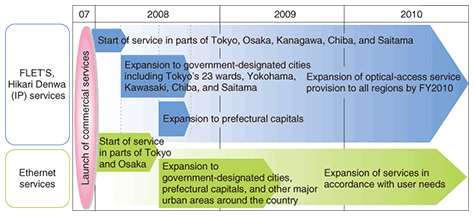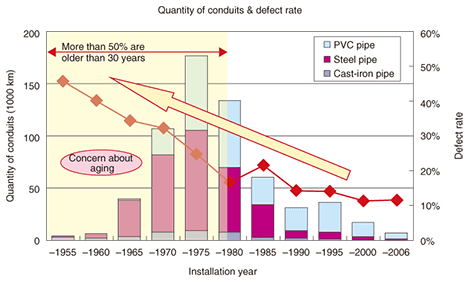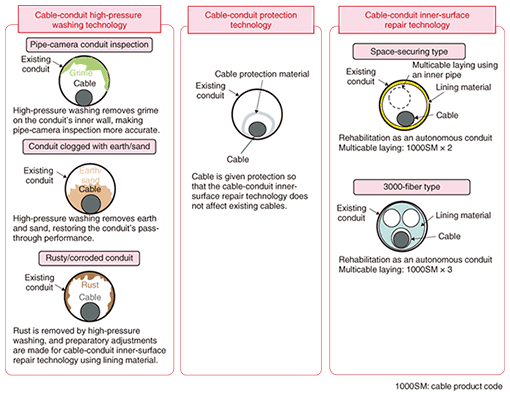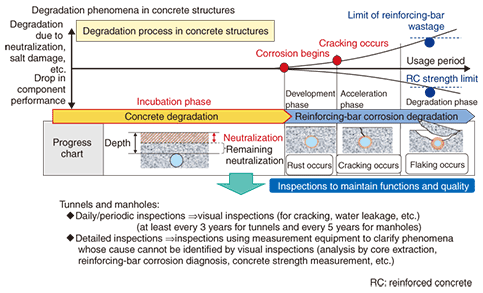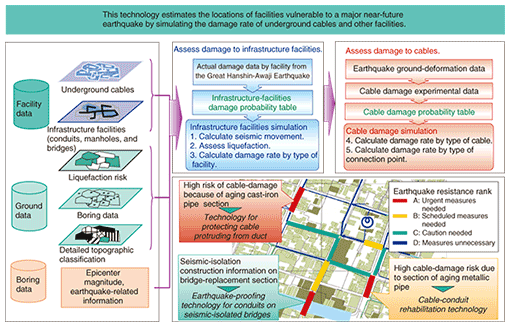 |
|||
|
|
|||
|
Special Feature: NTT Tsukuba Forum 2008 Workshop Lecture 2 Vol. 7, No. 6, pp. 12–18, June 2009. https://doi.org/10.53829/ntr200906sf2  Infrastructure Facilities Management Technology for Safe and Secure CommunicationsAbstractThis article reports on the current state of underground communication facilities and associated management technologies and describes preparations for dealing with major earthquakes to prevent damage to those facilities. Information-communication tools have become an indispensable part of society and daily life. Ensuring communications during times of disaster is NTT’s mission as a designated public corporation, and the lessons we have learned from past natural disasters and the damage they have caused are being incorporated into NTT’s research and development. This article is based on a presentation given at the Tsukuba Forum 2008 Workshop held on October 16, 2008.
1. IntroductionIn 2008, the number of FTTH (fiber-to-the-home) users overtook the number of DSL (digital subscriber line) users, which had already been on a downward trend, and the number of FTTH lines for NTT EAST and NTT WEST combined exceeded 10 million. The spread of FTTH has promoted the integration of traditionally independent networks associated with personal computers, land lines, and televisions, and as a result, the information-communications network has become an even greater part of our daily lives and an indispensable part of society. The Next Generation Network (NGN) is expected to provide services that exploit the merits of not only the telephone network, which can provide high-quality and highly reliable and secure voice services, but also those of the IP (Internet protocol) network that enables the economic provision of diversified services. The four main technical features of the NGN are quality of service, security, reliability, and open interfaces. The NTT Group launched commercial NGN services in March 2008 under a plan that calls for gradual expansion of the service coverage area (Fig. 1).
2. Natural disasters and disaster-prevention measures2.1 Past disasters, damage, and subsequent responsesThe threat of natural disasters can never be completely eliminated regardless of how many countermeasures are put into place. At NTT, lessons have been learned from the damage inflicted on communication services and communication facilities in the past by large-scale natural disasters, and efforts have been made to develop new disaster-prevention measures and improve the reliability of facilities. The origin of genuine disaster countermeasures is the Niigata Earthquake of 1964. In this earthquake, large-scale liquefaction was observed in detail for the first time. This disaster prompted NTT (then Nippon Telegraph and Telephone Public Corporation) to begin implementing earthquake countermeasures in underground facilities. Then, in the 1982 Nagasaki Flood Disaster, the operation of about 20,000 land lines in and around Nagasaki City was interrupted, and it was this experience that compelled NTT to develop countermeasures to long-term power outages. In addition, an underground-conduit fire at NTT’s Setagaya office in 1984 interrupted traffic carried by about 89,000 land lines. After this disaster, NTT began to develop thorough fire-prevention measures and to enhance its conduit-management system. Moving into the 1990s, typhoon No. 19, which hit Japan in 1991, brought down utility poles and snapped aerial cables resulting in the disconnection of about 300,000 land lines around the country. We responded to this disaster by strengthening utility poles, aerial cables, and other outdoor infrastructure facilities. The 1995 Great Hanshin-Awaji Earthquake (Kobe Earthquake) was a massive disaster in which service was lost in about 285,000 land lines as a result of immediate switch failures and in about 193,000 land lines as a result of subsequent fires. The lessons learned here led to the development of emergency communication services for a disaster such as the Dengon Dial voice message board. Scientists say that there is a high probability that a massive earthquake with a seismic intensity of 6 or greater will occur in the Tokyo metropolitan area or the Tokai region sometime within the next 30 years. Needless to say, there is an urgent need for enhanced earthquake countermeasures. 2.2 Mission as a member of the Central Disaster Prevention CouncilNTT is a designated public corporation on the authority of the Disaster Countermeasure Basic Act of Japan. It is also a member of the Central Disaster Prevention Council (an organization chaired by the prime minister and consisting of all cabinet ministers, the Bank of Japan, the Japanese Red Cross Society, NHK, NTT, and four academic experts for a total of 26 members). The preservation of communication channels at the time of a disaster is a prime mission of NTT as a telecommunications carrier. To fulfill this social role, NTT is studying specific countermeasures to physical devastation at the time of a large-scale disaster based on the following three points. (1) Improving network reliability
(2) Ensuring vital communications
(3) Enabling early restoration of services
3. Current state of communications infrastructure facilitiesIn developing technology for underground communication facilities, NTT researchers aim to improve the NTT Group brand by providing safe and secure underground space, providing safe and secure services that are robust to earthquakes and beneficial to the society, and contributing to the development and promotion of new business. Underground communication facilities are mainly divided into conduit and concrete types. As the names imply, conduit-type facilities are conduits that accommodate cables, and concrete-type facilities are concrete structures such as tunnels and manholes. NTT manages a huge quantity of underground facilities including 630,000 km of conduits (equivalent to circling the earth about sixteen times), 630 km of tunnels (equal to the direct distance between Tokyo and Hiroshima), and 690,000 manholes. However, the majority of these facilities were installed prior to NTT’s privatization in 1985. Since then, no new facilities have been practically constructed except for obstacle-removal purposes and in special cases. Consequently, the use of these vast existing facilities has become the basic premise for the development of underground facilities. Behind all this is the fact that simply owning facilities is extremely costly, so NTT would like to reduce costs and the number of engineering personnel through efficient and automated processes and to contribute to NGN migration and business expansion through development within the framework of existing facilities. 4. Trends in R&D technology for communications infrastructure facilities4.1 Conduit management technologyIn conduit facilities (mainly metal pipes), corrosion proceeds over time due to rust, grime, and clogging with earth and sand. This makes it difficult to install new cables in the conduits and makes it necessary to perform periodic inspections and conduit rehabilitation. Corrosion can be divided into two main types according to its form: full corrosion (in which rust adheres to the entire inner surface of the conduit forming lumps that reduce the diameter of free space within the conduit) and spot corrosion (in which holes open up locally in the conduit allowing earth and sand to penetrate). More than half of NTT’s existing conduits were installed more than 30 years ago. The conduit defect rate rises as conduits become older, so aging is a major issue (Fig. 2). However, the defect rate depends on the type of conduit: corrosion progresses remarkably quickly in metal (steel or cast-iron) pipes while the effects of corrosion over time in polyvinyl-chloride (PVC) pipes are practically nonexistent.
The defect rate also differs according to how the conduit is used. Among existing conduits, those that are actually being used (accommodating cables) make up about 60% of all conduits, and 60% of those suffer from some kind of defect. The remaining empty conduits have a defect rate of only 35%. Unlike empty conduits, however, cable conduits are difficult to inspect and rehabilitate. However, the dramatic expansion of FTTH lines has increased the need to accommodate both optical and metallic cables in the same conduit and to install many cables in one conduit. As a result, making effective use of conduits whose inner space has contracted due to rust or other problems has become a pressing issue. In response, we have researched technologies for inspecting and rehabilitating cable conduits quickly and inexpensively without affecting existing cables. First, for inspection work, we are developing automatic recognition technology using pipe camera images as an alternative to conventional visual inspection. Here, we pass a pipe camera through the interior of a conduit to capture images and then determine the progression of corrosion based on the colors in the images to obtain a quantitative assessment. Second, for rehabilitation work, we have developed cable-conduit high-pressure washing technology, which has been in use since 2007. This enables the intra-pipe washing usually used for empty conduits to be applied to conduits that contain cables. We are also in the process of developing cable-conduit protection technology and cable-conduit inner-surface repair technology (Fig. 3).
4.2 Concrete structure management technologyLike conduits, NTT tunnels and manholes are aging and more than half of them were constructed over 30 years ago. For the management of these old concrete structures, the basic issue is how to keep them healthy and usable for a long time. Concrete structures generally degrade through neutralization, salt damage, and other factors. This degradation proceeds in four phases: incubation phase (alkaline concrete reacts with carbon dioxide in the air resulting in neutralization), development phase (neutralization reaches reinforcing bars generating rust), acceleration phase (increasing rust exerts pressure on surrounding concrete resulting in microscopic cracking), and degradation phase (swelling rust causes flaking and fractures) (Fig. 4).
Degradation in tunnels and manholes is currently assessed visually, which means that degradation can be recognized only from the acceleration phase onwards when symptoms like cracking and water leaks begin to appear. Our aim, therefore, is to develop technology that can recognize degradation in earlier phases in an efficient and non-destructive manner and optimize costs by early rehabilitation. Specifically, this is technology that uses the macroscopic ultrasound method to judge the state of a concrete structure’s interior by emitting ultrasonic waves several thousand times, measuring reflected waves, and performing an averaging procedure. This method can be used to estimate concrete thickness, the distance to a reinforcing bar, the depth of cracks, the presence of voids, and various other things. We are also developing technology that uses ultrasonic waves to measure concrete strength and the state of corrosion of a reinforcing bar. In addition to tunnels and manholes, these technologies can also be applied to the inspection of utility poles. Also under development are technologies for automatically recognizing cracks in images taken with a digital camera as an alternative to normal visual inspection using binoculars and for inspecting breaks in reinforcing bars by measuring vibrations induced by light tapping. 4.3 Earthquake-proofing technologiesIn the aftermath of the 1964 Niigata Earthquake, NTT has implemented specific measures to prevent earthquake damage. These included a conduit design with a sliding mechanism to absorb earthquake vibrations and measures to mitigate the rising of manholes in areas having liquescent ground. The 1995 Great Hanshin-Awaji Earthquake also led to efforts to improve the flexibility of facilities and establish measures to protect cables in the event of a disaster as well as to prevent the collapse of dedicated conduit-carrying bridges. With regard to bridges, NTT has been using quake-absorbing structures in recent years. When an earthquake occurs, a bridge will oscillate in all directions (360°). Therefore, if we use only the conventional countermeasures that take into account oscillation in only the forward direction, there is a danger that bridge facilities could collapse, so development efforts have been focusing on more flexible connection technologies. 4.4 Operations technologyNTT is also working on ways to simulate the effects of a disaster to prepare for a major earthquake that is predicted to occur sometime in the near future. The aim here is to estimate the damage rate to facilities based on public data on past major earthquakes and ground data for each region and on data about underground cable facilities and infrastructure facilities. First to be quantified will be conditions related to damage to infrastructure facilities (calculation of seismic movement, assessment of liquefaction, and calculation of damage rate by type of facility). This will be followed by quantification of conditions related to damage to cables (calculation of damage rate by cable type and connection point type) (Fig. 5).
By sorting the results into five ranks of earthquake resistance, we can undertake inspection and rehabilitation on a priority basis starting from locations that have a high probability of sustaining damage in an earthquake and an urgent need for earthquake-proofing measures. Here, we should not forget that what needs to be protected is not so much the infrastructure facilities themselves but the cables that run through them. The main objective is to prevent a breakdown in communication services. We are presently working to improve the accuracy of the above technology by comparing the results of actual earthquakes with those of simulations. 5. ConclusionThe basic premise behind the development of underground communication facilities is the extensive use of existing facilities, but the reality is that the number of engineers is decreasing significantly. NTT must therefore provide its customers with safe and secure communication services within the severe constraint of maintaining aging facilities with a relatively small number of engineers. To this end, the effective use of facility data will become increasingly important. As facilities become complex, the amount of such data increases and it will be necessary to enhance existing relational databases to construct a more flexible database format. Looking forward, we aim to achieve a system that will autonomously set off alarms on the facility side so that necessary countermeasures can be taken in response. ProfileCareer highlightsProject Manager, Civil Engineering Project, NTT Access Network Service Systems Laboratories. Toshiaki Iida joined Nippon Telegraph and Telephone Public Corporation (now NTT) in 1984. From 1999, he contributed to the spread of No-DIG technology in AIREC, one of the NTT Group businesses. He has held his present position since 2008. |
|||








